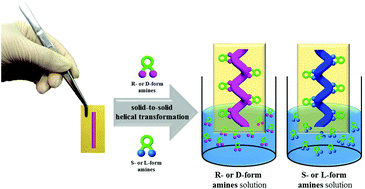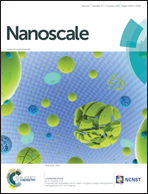Chirality control of self-assembled achiral nanofibers using amines in their solid state†
Abstract
Although there are numerous examples of helical and spiral conformations in nature, including plant tendrils, snail shells, and even collagen, the occurrence of supramolecular systems that are able to reversibly undergo solid-to-solid helical transformation based on environmental chiral triggers is rare. In this work, we present a supramolecular, non-helical nanofiber which shows a distinct helical rearrangement in the presence of specific diamines and monoamines, such as cyclohexanediamines, alanine, lysine, and phenylalanine, depending on the molecular chirality of the surrounding analytes. A detailed investigation on the structural organization of the nanofibers using SEM and CD spectra analysis confirmed the repeatable and reversible nature of this amplification of chiral information. Further preparation of an electrospun nanofiber film was demonstrated for distinguishing chiral diamines and monoamines in solution by film immersion and CD analysis, which is the first example of amplification of chiral information in the solid-state using electrospun nanofiber films. With this system, we could demonstrate a reusable means for detecting the molecular chirality, which also provided a unique example of reversible control of solid state rearrangement in supramolecular helicity.


 Please wait while we load your content...
Please wait while we load your content...